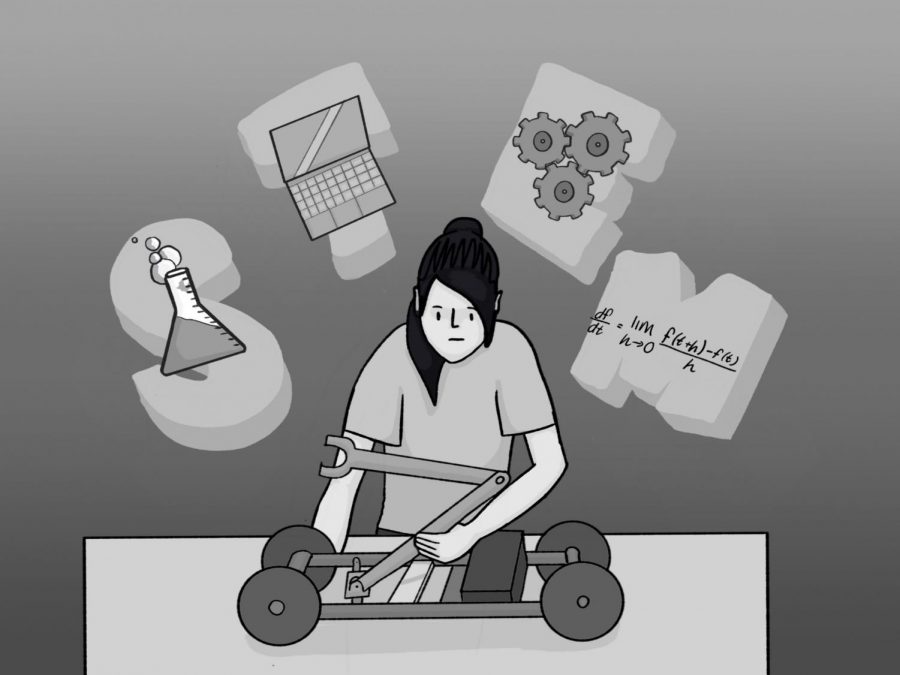CAMPUS: 49ers SLI program prepares its members to become proficient and experienced leaders
The 49ers STEM Leadership Institute offers many rigorous hands-on activities pertaining to STEM industries.
The 49ers STEM Leadership Institute is a six-year program offered for students to enhance their knowledge in STEM subjects and prepare them for the future. After completing the application process and being accepted, students begin the program in seventh grade at Cabrillo Middle School and work up through 12th grade at Santa Clara High School.
“The purpose of SLI is to graduate students that have a high level of comfort and proficiency in STEM fields and also have comfort being leaders,” project specialist Lauren Hayes said. “What we mean by that is having comfort with soft skills, collaboration, communication and those areas.”
To build comfort and expose students to several different fields, the SCHS FabLab is a designated resource equipped with technology for students to work on STEM projects with access to equipment, including 3-D printers, laser cutters, vinyl cutters and Shopbots.
SLI program and technology manager Laurie Toyama works with students to prepare them for the real-world industry through hands-on learning.
“We make them prototype first out of cardboard, and then they can use the actual material,” Toyama said. “It’s about learning, and I want to see mistakes because nothing is ever perfect, even in the real-world. That’s the importance of doing prototypes and making your mistakes there so that the mistake doesn’t come out in the actual product.”
For freshman Samuel Geevarghese, the FabLab has inspired him to work on projects with the use of advanced technology.
“My favorite thing is getting to use so many industry-level equipment and machinery to build so many different things you would think you couldn’t do,” Geevarghese said. “STEM clearly proved us wrong towards the thought of thinking you can’t do it.”
Alongside involvement in the program, students are encouraged to reflect deeply on their growth. The SLI program has allowed Geevarghese to develop his character with experience in team projects.
“It’s really helped shape better teamwork, or collaboration skills, even if the project that we work on doesn’t work out,” Geevarghese said. “My awareness and choice making in deciding how to go about certain things has improved compared to the beginning of STEM and being able to make decisions for not only myself, but that impacted me and my team in the best way possible.”
Similarly, senior Rhea Nair said the program has benefited her with a sense of direction and motivation to keep up with her classmates in addition in addition to discoveringdiscovering appealing careers earlier compared to her peers. Nair believes access to guest speakers, lectures and field trips helped her find her future passion, studying oncology.
“They give you a lot of opportunities to explore careers you’re interested in, and they expose you to information that you might not have found without STEM,” Nair said.
Some students feel that fulfilling the requirements of the program, however, can be challenging to students’ mental health. SLI students are expected to meet certain requirements for academics, extracurriculars and community service as well as making a commitment to at least 300 additional hours of learning outside of typical school hours.
“In STEM, you’re pressured and expected to make a certain requirement in which you feel if you’re not living up to, you don’t really belong,” Nair said.
According to Hayes, while a cohort of high-achieving students can drive and inspire each other, the competitive side of the program can be demoralizing for some.
“I think a lot of students see it as you’re either succeeding – you’re either winning – or you’re failing,” Hayes said. “A lot of times, failure is actually a great learning process, a great place to work on skills, a great place to identify where you want to grow.”
While the commitment can be stressful, Nair is thankful for the experience in aiding her to figure out a future plan.
“STEM kids in general feel a lot of pressure to keep up with each other, and there’s a lot of competition that pushes us to do better in every academic class or endeavor that we pursue,” Nair said. “But looking back, I think the opportunities and the exposure I’ve had has shaped who I want to be and what I want to pursue a lot earlier, so I don’t have to deal with that pressure later on.”


